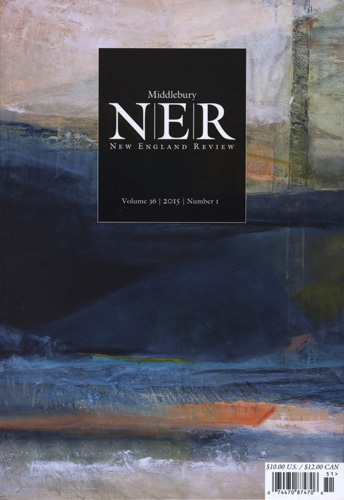New England Review – 2015
New England Review is a giant among literary magazines, published quarterly by Middlebury College, a small liberal arts college in Vermont. The current issue shows why New England Review deserves its sterling reputation. At 200 pages, it is filled with quality poetry, fiction, essays, and translations. There is no artwork, but as for literature, there is something for everybody: avant-garde free verse, stories set in slums and in high-rent New York, an academic piece on Herman Melville, and a reprint from an 1871 book on the old New England courtship rite called “bundling.” New England Review is a giant among literary magazines, published quarterly by Middlebury College, a small liberal arts college in Vermont. The current issue shows why New England Review deserves its sterling reputation. At 200 pages, it is filled with quality poetry, fiction, essays, and translations. There is no artwork, but as for literature, there is something for everybody: avant-garde free verse, stories set in slums and in high-rent New York, an academic piece on Herman Melville, and a reprint from an 1871 book on the old New England courtship rite called “bundling.” Contributors include university professors, a Pulitzer Prize winner, well-published authors from around the world, young and old, men and women. They may be diverse, but none are novices. That said, the stories and poems by famous names like Lore Segal, C. K. Williams, and William Logan are weaker than expected. If the editors solicit such work, instead of choosing the best of what comes in the door, they should rethink the practice with much of the lesser known writers offering more engaging writing in this issue.
On the other hand, the magazine repeatedly offers the greatest pleasure in literature—a text so interesting and so beautifully written that we read every word and forget what time it is. Most delightful are the six pieces of nonfiction.
Rachel Hadas does a close reading of a passage in Proust, on the decline and death of the narrator’s grandmother, and relates it to the last days of her husband George. She asks: “What is the best way to talk about people who are neither evidently alive nor evidently dead?” Jill Sisson Quinn in her essay “Big Night” not only makes me care about the mating habits of salamanders, human infertility, and the adoption process, but she artfully weaves these topics together. Rob Hardy does the same in “Naomi Mitchison, Peaceable Transgressor,” about a British biologist, friend of J. R. R. Tolkien, and advocate of birth control. Mitchison “established her reputation in the 1920s as the author of historical novels but later wrote fairy stories for children, a series of memoirs, and two pioneering works of feminist science fiction.” Lorraine Hanlon Comanor writes a memoir on figure skating in Switzerland during her youth in the 1960s, a topic I would normally shun, but she claims my undivided attention.
The academic paper, 32 pages long with footnotes and quotations, takes an obscure theme, “Melville’s Billy Budd and the Disguises of Authorship,” and turns it into a gripping detective story. We hear from Nathaniel Hawthorne; his contemporary Delia Bacon, who wrote about Shakespeare; and from Melville himself, whose tragic fable is probably based on recent naval history.
The six pieces of fiction are conventional stories with plot, dialogue, characters and atmosphere, but they range widely. Mario J. Gonzales in “Malditos” sketches life among poor Hispanic boys named Tweety, Tug and Cabezon—life that seems ordinary enough until Cabezon’s mother dies from a drug overdose. Carolyn Page in “Marksberry Road” captures the sound, taste, and empty look of her childhood many years ago in rural Kentucky. Lisa Taddeo in “Forty-Two” delves deep into the mind of a 42-year old career woman named Joan in New York today. Joan is a “cougar,” a well-heeled, physically fit woman with a taste for younger men. Brendan McKennedy in “Front Men Are Forever” presents a rock band, their sudden success, and the rivalry that breaks the group of young men apart: “You know what, Clark? I meant it all. I did. Everything Angela put in that article is true. I am the center of talent in this band.”
John Kinsella’s translations of four long poems by Auguste Lacaussade (1815-1897) evoke nature, and they echo the French poet’s ecstatic voice. Erin Lynch in “The Tanner’s Bride” tells a story with “the reek of tepid flesh.” Anders Carlson-Wee in “Shoalwater” observes the action of waves, crabs, gulls and clams, and he relates the scene to mourning: “When I dream about my brother he disappears / if I look.”
Contributors include university professors, a Pulitzer Prize winner, well-published authors from around the world, young and old, men and women. They may be diverse, but none are novices. That said, the stories and poems by some of the famous names fall short of the rest, leaving me to wonder: Did the editors solicit these pieces? New England Review could forego this practice, and our pleasure would not diminish.
[www.nereview.com]





